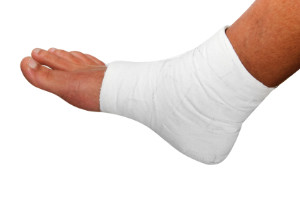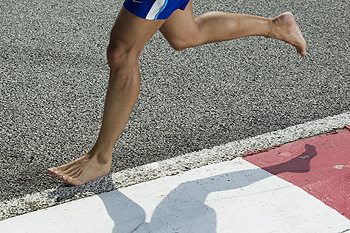March 2018
What is Tarsal Tunnel Syndrome?
 The tarsal tunnel is a canal that exists between the ligaments that spans across the foot and a portion of the ankle bone. The nerves and tendons that are inside this tunnel allow mobility and enable the foot to easily point and flex. If a specific nerve called the tibial nerve inside this canal should become compressed, typically resulting from an injury, this condition is referred to as tarsal tunnel syndrome. Having flat feet is a possible reason for this condition, causing the tibial nerve to become strained. Certain health issues, such as arthritis and diabetes, may also cause the nerve to endure swelling and increased pressure. The nerve must be allowed to heal properly, and this may be accomplished by wearing a brace or supportive shoes. The discomfort that is experienced may be indicative of other foot-related conditions, so it’s advised to consult a podiatrist for a proper diagnosis
The tarsal tunnel is a canal that exists between the ligaments that spans across the foot and a portion of the ankle bone. The nerves and tendons that are inside this tunnel allow mobility and enable the foot to easily point and flex. If a specific nerve called the tibial nerve inside this canal should become compressed, typically resulting from an injury, this condition is referred to as tarsal tunnel syndrome. Having flat feet is a possible reason for this condition, causing the tibial nerve to become strained. Certain health issues, such as arthritis and diabetes, may also cause the nerve to endure swelling and increased pressure. The nerve must be allowed to heal properly, and this may be accomplished by wearing a brace or supportive shoes. The discomfort that is experienced may be indicative of other foot-related conditions, so it’s advised to consult a podiatrist for a proper diagnosis
Tarsal tunnel syndrome can be very uncomfortable to live with. If you are experiencing tarsal tunnel syndrome, contact Dr. Nahid Birjandi of Mission Viejo, CA. Our doctor can provide the care you need to keep you pain-free and on your feet.
Tarsal Tunnel Syndrome
Tarsal tunnel syndrome, which can also be called tibial nerve dysfunction, is an uncommon condition of misfiring peripheral nerves in the foot. The tibial nerve is the peripheral nerve in the leg responsible for sensation and movement of the foot and calf muscles. In tarsal tunnel syndrome, the tibial nerve is damaged, causing problems with movement and feeling in the foot of the affected leg.
Common Cause of Tarsal Tunnel Syndrome
- Involves pressure or an injury, direct pressure on the tibial nerve for an extended period of time, sometimes caused by other body structures close by or near the knee.
- Diseases that damage nerves, including diabetes, may cause tarsal tunnel syndrome.
- At times, tarsal tunnel syndrome can appear without an obvious cause in some cases.
The Effects of Tarsal Tunnel Syndrome
- Different sensations, an afflicted person may experience pain, tingling, burning or other unusual sensations in the foot of the affected leg.
- The foot muscles, toes and ankle become weaker, and curling your toes or flexing your foot can become difficult.
- If condition worsens, infections and ulcers may develop on the foot that is experiencing the syndrome.
A physical exam of the leg can help identify the presence of tarsal tunnel syndrome. Medical tests, such as a nerve biopsy, are also used to diagnose the condition. Patients may receive physical therapy and prescriptive medication. In extreme cases, some may require surgery.
If you have any questions please feel free to contact our office located in Mission Viejo, CA. We offer the newest diagnostic and treatment technologies for all your foot and ankle needs.
Read more about Tarsal Tunnel SyndromeA Common Injury Among Tennis Players
 A common ailment that many tennis players are affected by are ankle sprains. The ligaments on the outside of the foot are weaker than those on the inside and may have difficulty in protecting the ankle if it should turn inward. You may have trouble differentiating between a sprain and a break, and it often becomes necessary to have an X-ray performed. Common symptoms may include severe pain and swelling, in addition to discoloration of the skin. Resting the foot is an important first step in healing from this injury, in addition to ceasing all activities including walking. The swelling will subside when the the foot is elevated and will generally feel better. After the recovery period begins, performing certain exercises will help the ankle to become stronger, and the tennis games can resume. One way to possibly prevent this injury is to wear proper footwear while playing tennis. Specifically, tennis shoes are designed in a way to prevent injuries. It would be advised to purchase a pair before partaking in the sport. If you think you may have sprained your ankle during a game of tennis or have any questions or concerns, scheduling an appointment with a podiatrist is advised.
A common ailment that many tennis players are affected by are ankle sprains. The ligaments on the outside of the foot are weaker than those on the inside and may have difficulty in protecting the ankle if it should turn inward. You may have trouble differentiating between a sprain and a break, and it often becomes necessary to have an X-ray performed. Common symptoms may include severe pain and swelling, in addition to discoloration of the skin. Resting the foot is an important first step in healing from this injury, in addition to ceasing all activities including walking. The swelling will subside when the the foot is elevated and will generally feel better. After the recovery period begins, performing certain exercises will help the ankle to become stronger, and the tennis games can resume. One way to possibly prevent this injury is to wear proper footwear while playing tennis. Specifically, tennis shoes are designed in a way to prevent injuries. It would be advised to purchase a pair before partaking in the sport. If you think you may have sprained your ankle during a game of tennis or have any questions or concerns, scheduling an appointment with a podiatrist is advised.
Ankle sprains are common, but need immediate attention. If you need your feet checked, contact Dr. Nahid Birjandi from Mission Viejo, CA. Our doctor can provide the care you need to keep you pain-free and on your feet.
How Does an Ankle Sprain Occur?
Ankle sprains take place when the ligaments in your ankle are torn or stretched beyond their limits. There are multiple ways that the ankle can become injured, including twisting or rolling over onto your ankle, putting undue stress on it, or causing trauma to the ankle itself.
What are the Symptoms?
- Mild to moderate bruising
- Limited mobility
- Swelling
- Discoloration of the skin (depending on severity)
Preventing a Sprain
- Wearing appropriate shoes for the occasion
- Stretching before exercises and sports
- Knowing your limits
Treatment of a Sprain
Treatment of a sprain depends on the severity. Many times, people are told to rest and remain off their feet completely, while others are given an air cast. If the sprain is very severe, surgery may be required.
If you have suffered an ankle sprain previously, you may want to consider additional support such as a brace and regular exercises to strengthen the ankle.
If you have any questions please feel free to contact our office located in Mission Viejo, CA. We offer the newest diagnostic and treatment technologies for all your foot and ankle needs.
Read more about Ankle SprainsWounds that Don't Heal Need to be Checked
Should My Child Walk Barefoot?
 Children typically learn to walk at about 12 months of age. Most babies are born with flat feet, and their feet are extremely flexible because of the excess fat surrounding the numerous bones, muscles, and tendons the foot is comprised of. As walking progresses and the feet get stronger, the condition of flat feet will generally improve. Balance can be learned and improved by encouraging the child to walk barefoot as often as possible. When it’s time to wear shoes, the feet must be measured every few months because of the rapid growth that is experienced. When the length and width of the foot are properly measured and the correct size is determined, the shoes that are worn should fit firmly and comfortably. It is important to be aware of your child’s feet, which will aid in noticing if any foot conditions are present. Some of these may include any pain being experienced while waking, painful toenails which may be indicative of an ingrown toenail, or any stiffness in the feet. Please consider scheduling a consultation with a podiatrist if you have questions about how your child’s feet are developing.
Children typically learn to walk at about 12 months of age. Most babies are born with flat feet, and their feet are extremely flexible because of the excess fat surrounding the numerous bones, muscles, and tendons the foot is comprised of. As walking progresses and the feet get stronger, the condition of flat feet will generally improve. Balance can be learned and improved by encouraging the child to walk barefoot as often as possible. When it’s time to wear shoes, the feet must be measured every few months because of the rapid growth that is experienced. When the length and width of the foot are properly measured and the correct size is determined, the shoes that are worn should fit firmly and comfortably. It is important to be aware of your child’s feet, which will aid in noticing if any foot conditions are present. Some of these may include any pain being experienced while waking, painful toenails which may be indicative of an ingrown toenail, or any stiffness in the feet. Please consider scheduling a consultation with a podiatrist if you have questions about how your child’s feet are developing.
Making sure that your children maintain good foot health is very important as they grow. If you have any questions, contact Dr. Nahid Birjandi of Mission Viejo, CA. Our doctor can provide the care you need to keep you pain-free and on your feet.
Keeping Children's Feet Healthy
Having healthy feet during childhood can help prevent medical problems later in life, namely in the back and legs. As children grow, their feet require different types of care. Here are some things to consider...
Although babies do not walk yet, it is still very important to take care of their feet.
Avoid putting tight shoes or socks on his or her feet.
Allow the baby to stretch and kick his or her feet to feel comfortable.
As a toddler, kids are now on the move and begin to develop differently. At this age, toddlers are getting a feel for walking, so don’t be alarmed if your toddler is unsteady or ‘walks funny’.
As your child gets older, it is important to teach them how to take care of their feet.
Show them proper hygiene to prevent infections such as fungus.
Be watchful for any pain or injury.
Have all injuries checked by a doctor as soon as possible.
Comfortable, protective shoes should always be worn, especially at play.
If you have any questions please feel free to contact our office located in Mission Viejo, CA. We offer the newest diagnostic and treatment technologies for all your foot and ankle needs.
Read more about What to Do to Keep Your Child’s Feet HealthyHow Stress Fractures Affects Runners
 If you’re a disciplined and serious runner, one of the most uncomfortable things that can happen is to endure a stress fracture. This condition is typically frequent among runners, commonly due to the repeated force that’s applied when the foot meets the ground. Runners will often ignore the dull pain when the fracture first occurs, but this will only worsen the condition. There are generally no obvious symptoms for stress fractures, such as bruising or excessive swelling, so obtaining a proper diagnosis may be difficult. Having an MRI performed may possibly be an effective method of determining whether a stress fracture exists, as the pain may be indicative of other ailments that result in similar foot pain. Treatment plans that allow the fracture to heal completely can involve ceasing all running activities temporarily and wearing a walking boot to help with stability. It typically takes 6-8 weeks to completely heal the fracture, and practicing non-impact activities, such as swimming, can aid in the desire for cardiovascular exercise. A consultation with a podiatrist is suggested if you have any questions regarding stress fractures.
If you’re a disciplined and serious runner, one of the most uncomfortable things that can happen is to endure a stress fracture. This condition is typically frequent among runners, commonly due to the repeated force that’s applied when the foot meets the ground. Runners will often ignore the dull pain when the fracture first occurs, but this will only worsen the condition. There are generally no obvious symptoms for stress fractures, such as bruising or excessive swelling, so obtaining a proper diagnosis may be difficult. Having an MRI performed may possibly be an effective method of determining whether a stress fracture exists, as the pain may be indicative of other ailments that result in similar foot pain. Treatment plans that allow the fracture to heal completely can involve ceasing all running activities temporarily and wearing a walking boot to help with stability. It typically takes 6-8 weeks to completely heal the fracture, and practicing non-impact activities, such as swimming, can aid in the desire for cardiovascular exercise. A consultation with a podiatrist is suggested if you have any questions regarding stress fractures.
Activities where too much pressure is put on the feet can cause stress fractures. To learn more, contact Dr. Nahid Birjandi from Mission Viejo, CA. Our doctor can provide the care you need to keep your pain free and on your feet.
Dealing with Stress Fractures of the Foot and Ankle
Stress fractures occur in the foot and ankle when muscles in these areas weaken from too much or too little use. The feet and ankles then lose support when walking or running from the impact of the ground. Since there is no protection, the bones receive the full impact of each step. Stress on the feet can cause cracks to form in the bones, thus creating stress fractures.
What are Stress Fractures?
Stress fractures occur frequently in individuals whose daily activities cause great impact on the feet and ankles. Stress factors are most common among:
- Runners
- People affected with Osteoporosis
- Tennis or basketball players
- Gymnasts
- High impact workouts
Symptoms
Pain from the fractures occur in the area of the fractures and can be constant or intermittent. It will often cause sharp or dull pain with swelling and tenderness. Engaging in any kind of activity which involves high impact will aggravate pain.
If you have any questions please feel free to contact our office located in Mission Viejo, CA. We offer the newest diagnostic and treatment technologies for all your foot and ankle needs.
Read more about Dealing with Stress Fractures of the Foot and Ankle







